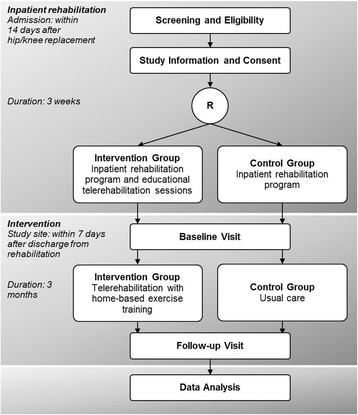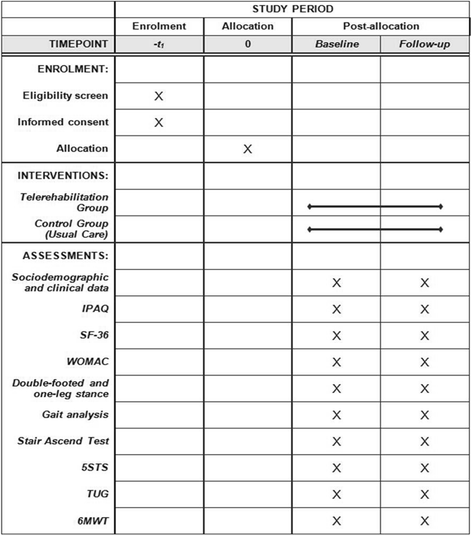Effectiveness of an interactive telerehabilitation system with home-based exercise training in patients after total hip or knee replacement: study protocol for a multicenter, superiority, no-blinded randomized controlled trial
- PMID: 28934966
- PMCID: PMC5608184
- DOI: 10.1186/s13063-017-2173-3
Effectiveness of an interactive telerehabilitation system with home-based exercise training in patients after total hip or knee replacement: study protocol for a multicenter, superiority, no-blinded randomized controlled trial
Abstract
Background: Total hip or knee replacement is one of the most frequently performed surgical procedures. Physical rehabilitation following total hip or knee replacement is an essential part of the therapy to improve functional outcomes and quality of life. After discharge from inpatient rehabilitation, a subsequent postoperative exercise therapy is needed to maintain functional mobility. Telerehabilitation may be a potential innovative treatment approach. We aim to investigate the superiority of an interactive telerehabilitation intervention for patients after total hip or knee replacement, in comparison to usual care, regarding physical performance, functional mobility, quality of life and pain.
Methods/design: This is an open, randomized controlled, multicenter superiority study with two prospective arms. One hundred and ten eligible and consenting participants with total knee or hip replacement will be recruited at admission to subsequent inpatient rehabilitation. After comprehensive, 3-week, inpatient rehabilitation, the intervention group performs a 3-month, interactive, home-based exercise training with a telerehabilitation system. For this purpose, the physiotherapist creates an individual training plan out of 38 different strength and balance exercises which were implemented in the system. Data about the quality and frequency of training are transmitted to the physiotherapist for further adjustment. Communication between patient and physiotherapist is possible with the system. The control group receives voluntary, usual aftercare programs. Baseline assessments are investigated after discharge from rehabilitation; final assessments 3 months later. The primary outcome is the difference in improvement between intervention and control group in 6-minute walk distance after 3 months. Secondary outcomes include differences in the Timed Up and Go Test, the Five-Times-Sit-to-Stand Test, the Stair Ascend Test, the Short-Form 36, the Western Ontario and McMaster Universities Osteoarthritis Index, the International Physical Activity Questionnaire, and postural control as well as gait and kinematic parameters of the lower limbs. Baseline-adjusted analysis of covariance models will be used to test for group differences in the primary and secondary endpoints.
Discussion: We expect the intervention group to benefit from the interactive, home-based exercise training in many respects represented by the study endpoints. If successful, this approach could be used to enhance the access to aftercare programs, especially in structurally weak areas.
Trial registration: German Clinical Trials Register (DRKS), ID: DRKS00010009 . Registered on 11 May 2016.
Keywords: Aftercare; Exercise therapy; Home-based; Telerehabilitation; Total hip replacement; Total knee replacement.
Conflict of interest statement
Authors’ information
Not applicable.
Ethics approval and consent to participate
The trial has approval of the Ethics Committee of the University of Potsdam (No. 15/2016). Patients must provide written, informed consent before any study procedures occur.
Consent for publication
Not applicable.
Competing interests
The authors declare that they have no competing interests.
Publisher’s Note
Springer Nature remains neutral with regard to jurisdictional claims in published maps and institutional affiliations.
Figures


References
-
- OECD . Health at a glance 2015: OECD indicators. Paris: OECD Publishing; 2015. Hip and knee replacement.
-
- Deutsche Rentenversicherung Bund. Reha-Therapiestandards Hüft-und Knie-TEP für die medizinische Rehabilitation der Rentenversicherung. DRV Bund. Berlin; 2016. http://www.deutsche-rentenversicherung.de/Allgemein/de/Inhalt/3_Infos_fu....
Publication types
MeSH terms
LinkOut - more resources
Full Text Sources
Other Literature Sources
Medical

